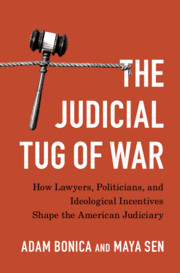 The Judicial Tug of War
The Judicial Tug of War from II - Political Actors and the Incentive to Politicize
Published online by Cambridge University Press: 09 December 2020
Federal courts only represent one kind of selection mechanism – appointment by the executive with the advice and consent of a legislative chamber. Because selection mechanisms vary across different jurisdictions, Chapter 6 explores how patterns may vary with regard to state courts. Indeed, part of our overall argument is that different selection mechanisms can both restrain and facilitate the incorporation of politics into judicial selection. As we show, appointments systems – like the appointments process used to name federal judges – are more sensitive to the needs and preferences of the political parties; by contrast, systems that lean toward merit-oriented criteria – including systems that are reliant on merit commissions, nonpartisan bodies, and local and state bar associations – are more sensitive to the needs and preferences of the bar. Thus, given the tension between political actors and the bar that characterizes the judicial tug of war, certain judicial selection systems may (or may not) be favorable to the different players. In other words, judicial selection mechanisms set the rules by which the tug of war is played.
To save this book to your Kindle, first ensure no-reply@cambridge.org is added to your Approved Personal Document E-mail List under your Personal Document Settings on the Manage Your Content and Devices page of your Amazon account. Then enter the ‘name’ part of your Kindle email address below. Find out more about saving to your Kindle.
Note you can select to save to either the @free.kindle.com or @kindle.com variations. ‘@free.kindle.com’ emails are free but can only be saved to your device when it is connected to wi-fi. ‘@kindle.com’ emails can be delivered even when you are not connected to wi-fi, but note that service fees apply.
Find out more about the Kindle Personal Document Service.
To save content items to your account, please confirm that you agree to abide by our usage policies. If this is the first time you use this feature, you will be asked to authorise Cambridge Core to connect with your account. Find out more about saving content to Dropbox.
To save content items to your account, please confirm that you agree to abide by our usage policies. If this is the first time you use this feature, you will be asked to authorise Cambridge Core to connect with your account. Find out more about saving content to Google Drive.